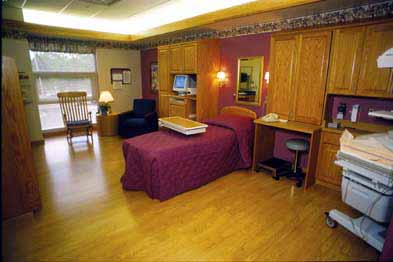Community Profile

|
Left: The new birthing rooms at Johnston Memorial Hospital offer
state-of-the-art equipment and comforts for expectant mothers
|
How a Hospital Healed Itself
and Made an Entire County Healthy
To
gauge the overall health — not to mention potential — of Johnston
County, look no further than its medical care system, which grows more
robust with each passing day.
Johnston Memorial Hospital has been the principal provider of care for
Johnstonians since 1951. For decades the county facility’s delivery
of services was competent, its technological progress incremental.
With the 1990s, though, came a confluence of circumstances that would
lead to major capital improvement projects resulting in a modern, more
consumer oriented and technologically advanced operation.
In the late 1970s, Leland Farnell served as Johnston Memorial’s
chief financial officer. When he returned to the hospital in 1991 as
its president he had no way of knowing he was in for the ride of his
life. A tsunami of newcomers would elevate Johnston’s income and
educational levels as well as expectations about a variety of
services, including healthcare. Meanwhile, longtime residents,
particularly those who were more senior in years, would make it clear
in surveys that they wanted ready access to specialized care such as
cardiology.
By 1994, Farnell, his fellow administrators and the hospital’s board
of trustees were developing a blueprint for change. Then, in May of
that year a medical emergency of major proportions gave even more
impetus to the priorities they been working to set. An Amtrak train
wreck within the county sent nearly 400 passengers to Johnston
Memorial’s emergency room (after medical personnel triaged more than
700 people at the accident site). To be sure, any ER would have been
taxed by such an avalanche. Nonetheless, it was clear just how
inadequate the emergency department with its eight beds had become.
An improvement program, including a three-phase, $13 million
renovation of the aging hospital, was launched. Today, the five-story,
175-bed facility contains space for 145 medical and surgical beds, a
10-bed intensive care unit and 20 psychiatric beds. There’s a new
same-day surgery center and the radiology department has been beefed
up. The emergency room, which now boasts 28 beds, and the county’s
health department, while operating independently, share a large space
on the ground floor of Johnston Memorial. It is, explains Farnell,
“a symbiotic partnership.” People who arrive at the ER and need a
consultation with the health department can easily get it. Likewise,
when necessary, emergency can use the health department’s beds.
The state-of-the-art Women’s Pavilion opened this past January and
supplanted the cramped, out-of-the-way space used for maternity care
and childbirth. In August, the hospital’s three full-time
cardiologists will have a new, fixed cardiac catheterization lab. This
replaces the mobile cath lab that has been in use since the mid-1990s.
Three satellite facilities extend Johnston Memorial’s reach.
There’s Johnston Family Care in Kenly, Johnston Family Care Center
in McGee’s Crossroads and the QuikMed Urgent Care Center in Garner.
In a stunning example of reclamation and reuse, the hospital purchased
a shuttered textile mill that sat immediately adjacent to its campus
and elected to create from it the Johnston Medical Mall. The
260,000-square-foot space will house a community auditorium, wellness
center, doctor’s offices, retail outlets for medical supplies, and
the Johnston Cancer Center. Currently, the center, a collaboration
with Duke University, is housed at the hospital. Conversion of the
space should be completed by year’s end. “We’ve done our best to
develop product lines that reflect what consumers are telling us they
want and what we know about the diseases affecting the people of
Johnston County,” says Farnell.
Yet another alliance of Johnston Memorial and Duke Medical Center will
be evident in the first quarter of 2003 when the two organizations
move into leased space they’ll share at the Summit Medical Centre
now being built in Clayton. The 32,000-square-foot building, the first
and largest of four buildings that ultimately will comprise the
center, will contain an outpatient surgical center on the first floor
and doctors’ offices on the second. Staff physicians from JMH as
well as those affiliated with the hospital from Duke will use the $1.2
million facility.
Nor have the demographics of western Johnston County escaped the
notice of other providers of medical care. WakeMed of neighboring Wake
County entered the market in April 2001 with the opening of a
38,000-square-foot facility in the Medical Park of Clayton. WakeMed
Clayton offers outpatient rehabilitation programs (physical,
occupational and speech therapy), laboratory services and radiology.
In addition, says Debra Laughery, a WakeMed spokesperson, an
orthopedics practice, an ob-gyn practice and a urology practice will
soon join the cardiologists, pediatricians and podiatrists who already
are leasing space in the building.
“Johnston Memorial Hospital is well-regarded. However, we believe
there’s still room for more healthcare offerings in Johnston County,
and our goal as an organization is to be readily available to
consumers.” She adds that there are no plans to open a hospital in
Johnston; theirs will “always be an outpatient facility.”
The Medical Park’s site plan does allow for two more buildings. They
will be added based on need. Where there’s growth there’s need, so
the prognosis for the future, allows Laughery, is “very good
indeed.” -- Lisa
H. Towle
Return
to magazine index
|

